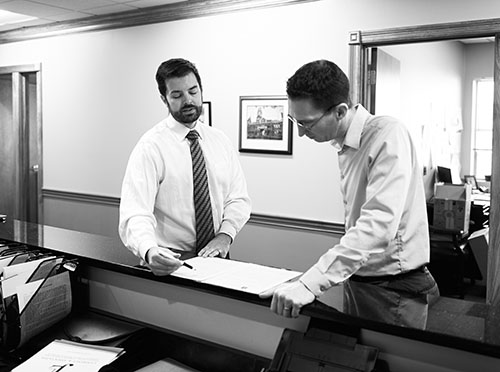Understanding Workers’ Compensation Law
Posted on Friday, May 27th, 2016 at 8:07 am
The following post is part of our Law Student Blog Writing Project, and is authored by Mark Ashley Hatfield, a Juris Doctor student at the University of Kentucky College of Law.
“Arising out of” & “In the Course of” Employment – Workers’ Compensation Law
 Understanding workers’ compensation can be a tricky task. The general concept of workers’ compensation can be broken down into a few simple questions: who was injured; what was the injury; and how did the injury occur? As you can imagine, depending on the nature of the job, these factors will always produce different results. This article will seek to explain a sometimes confusing topic that arises out of the how factor of the questions above.
Understanding workers’ compensation can be a tricky task. The general concept of workers’ compensation can be broken down into a few simple questions: who was injured; what was the injury; and how did the injury occur? As you can imagine, depending on the nature of the job, these factors will always produce different results. This article will seek to explain a sometimes confusing topic that arises out of the how factor of the questions above.
Although the how factor changes with different injuries, the process by which the injury is analyzed does not. When analyzing the how factor, as with any of the above factors, it is extremely important to understand how the term “Injury” is defined. Each state has its own workers’ compensation law so it is always important to note any jurisdictional differences; still, definitions of “Injury” are generally the same. To demonstrate, below is a look at the relevant statutes of Kentucky and Ohio. Kentucky Revised Statute § 342.0011(1) defines “Injury” as follows:
“Injury” means any work-related traumatic event or series of traumatic events, including cumulative trauma, arising out of and in the course of employment which is the proximate cause producing a harmful change in the human organism evidenced by objective medical findings.
Similarly, the Ohio Revised Code Annotated § 4123.01 defines “Injury” to include: “any injury, whether caused by external accidental means or accidental in character and result, received in the course of, and arising out of, the injured employee’s employment.” The Ohio statutory law includes a similar proximate cause requirement as well.
These definitions seem simple enough but, when broken down, they become a bit more complex. The beginnings of the sentences do not pose much of a problem as they each include, in their respective definitions, “any” injury that is a result of the employees work or employment. The logical connection would lead a person to believe that (minus the exclusions laid out by the statutes themselves) the use of “any” would cover any injury that could occur. Unfortunately, that is not always the case, and understanding workers’ compensation law is not always that simple.
Both statutes follow their all-encompassing definition with similar qualifiers. In both statutory provisions, immediately after saying Injury means “any” injury the employee suffers while at work, the statutes say that the injury must be one “arising out of” and “in the course of employment.” Meeting these two requirements is not as easy as it may appear. At first glance, it is actually pretty difficult to tell the difference between the two. For example, a couple of reasonable question to these definitions might be, would an injury not “arise out of” employment if it happened “in the course of” employment? Similarly, would something not happen “in the course of” employment if it “arose out of” employment? Although these phrases are made to be interpreted liberally by the courts, there is a significant difference between the two. When beginning to analyze a workers’ compensation claim it is important to note those differences, and this article will seek to help in that analysis.
First, we will take a look at the “arising out of” element. As described in Fisher v. Mayfield, an Ohio Supreme Court case, there must a “causal connection” between the employment and the injury itself. In Fisher, a teacher was injured at another school in her school district when she stopped to collect donations for a voluntary fund not sponsored by the school district. The causal connection is an element that can be evidenced through the actions, the evidence, or the environment of the employment. In describing how to analyze this connection, the Fisher court cites an older Ohio case, Lord v. Daugherty, which provides factors to use when analyzing the “arising out of” element; the Lord factors include: proximity, control, and benefit to the employer.
When analyzing the first factor, the court in Fisher said that the claimant met the requirement because she was already on a campus controlled by the employer. An employee does not have to physically be at her employment site when the injury occurs but, as you can imagine, the court’s analysis of this factor becomes much more complicated when the employee is injured away from her job site. Next, the control element looks to whether the employer has control of the area where the employee was injured. The court in Fisher expressly disagreed with the argument that the control element related to the employer’s control over the employee’s actions. Conversely, the court leaned towards a different argument. The argument being that, so long as the employer can be shown to have control over the site of the injury itself, the control element will be met. Finally, the injury must be shown to have occurred during an act that served the benefit of the employer. The court in Fisher found, as many other courts have, that even social events that serve to boost company morale can be viewed as a benefit to an employer, so this element was met as well.
Next, the “in the course of” employment element of workplace injuries can be viewed as a time and place type of element. Another Ohio Supreme Court opinion describes this element very well. Ruckman v. Cubby Drilling says that this term was set in place to limit “compensable injuries to those sustained by an employee while performing a required duty in the employer’s service.” The case goes further into explanation to say that in order to be entitled to a workers’ compensation claim, a claimant:
need not necessarily be injured in the actual performance of work for his employer. An injury is compensable if it is sustained by an employee while that employee engages in activity that is consistent with the contract for hire and logically related to the employer’s business.
Thus, any event that occurs in furtherance of the employment contract is arguably within the meaning of “in the course of” employment. In Ruckman, the injured employees were well-drillers who were injured in a traffic accident on the way to the job site. As a general rule, travel to and from work is not a covered event. However, given that there was no set place for employment and part of the job duties included daily travel to different work sites, the employee’s travel was covered by workers’ compensation.
This article is by no means a complete summarization of workers’ compensation law. It is not even a complete summarization of how an injury is defined for the purposes of workers’ compensation claims. This article is merely a starting point to see where an injury may be viewed from a workers’ compensation perspective. In addition to analyzing the types of injuries that “arise out of” and “in the course of” employment, as we did in this article, every jurisdiction has specific exclusions that we were unable to touch on. Hopefully no reader ever has to endure a workplace injury, but if you do, it is vitally important that you understand where to begin analyzing your situation.









